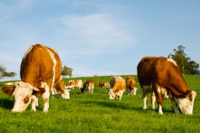Wisconsin accounted for two-thirds of the drop in output, and that was a direct reflection of declining milk production, according to market analyst Jerry Dryer, president of J/D/G Consulting in Chicago. "If Mother Nature cooperates, milk production should be up 2.5 percent this year," which will lead to increased cheese production this year, he says.
Wisconsin leads the nation in cheese production, accounting for 26 percent of the market, down half a point from 2000. California gained a 1.7 percent share of the national market and now accounts for 20 percent of output. With two major plants (Land 'O Lakes and Leprino) expected to come on line later this year in southern California, that is a trend that will continue.
"California currently has enough new cheese plants under construction or in the planning stages to deliver at least another 300 million pounds of cheese by the end of 2004," predicts Stand G. Andre, CEO of the California Milk Advisory Board. "That, combined with continued increased production at existing plants, clearly indicates California will become the country's largest cheese producer within the next few years."
Last year's production shortfall helped solidify market prices, though by how much is not clear. "Consumption was up 1 to 1.5 percent last year, despite a decline in production," Dryer observes. "That probably helped prices, though there is always cheese in inventory and more imports."

